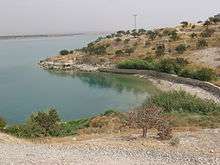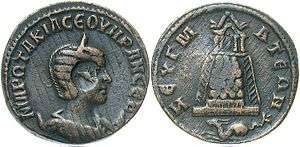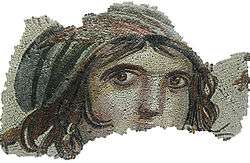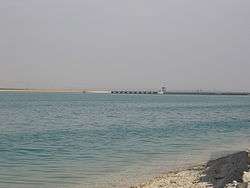Zeugma, Commagene
| Ζεῦγμα | |
 Parts of Zeugma have become submerged in the Euphrates River since the construction of the Birecik Dam | |
 Shown within Turkey | |
| Location | Belkis, Gaziantep Province, Turkey |
|---|---|
| Region | Commagene |
| Coordinates | 37°3′31″N 37°51′57″E / 37.05861°N 37.86583°ECoordinates: 37°3′31″N 37°51′57″E / 37.05861°N 37.86583°E |
| Type | Settlement |
| History | |
| Builder | Seleucus I Nicator |
| Founded | 300 BC |
| Site notes | |
| Condition | Partially submerged |
Zeugma (Greek: Ζεῦγμα) is an ancient city of Commagene; located in modern Gaziantep Province, Turkey. It was named for the bridge of boats, or zeugma,[1] that crossed the Euphrates river at that location.
Historical background
Originally, the ancient city of Zeugma was founded as a Greek settlement by Seleucus I Nicator, one of the generals of Alexander the Great, in 300 BC. The city was called "Zeugma", because of the bridge across the Euphrates River that was made of pontoons, thus connecting the two banks of the river. In Greek, "zeugma" means “bridge” or “crossing”. The ancient term Zeugma actually referred to the twin cities on the opposing banks of the river. Today the name Zeugma is usually understood to refer to the settlement on the west bank, called Seleucia on the Euphrates (Greek: Σελεύκεια) after the founder, while the one on the East bank was called Apamea after his Persian wife Apama.[2] The population of the city at its peak was approximately 80,000.
In 64 BC the city was conquered and ruled by the Roman Empire. During Roman rule, the city became one of the attractions in the region, due to its commercial potential originating from its geo-strategic location because the city was on the Silk Road connecting Antioch to China via a bridge of pontoons across the river Euphrates, which defined the border with the Persian Empire until the late 2nd century.
In 256 AD, Zeugma experienced an invasion and was destroyed by the Sassanid king, Shapur I. The damage from the invasion was so drastic that Zeugma was not able to recover for a long time. To make the situation even worse, a violent earthquake buried the city beneath rubble. Indeed, during the rest of its time under Roman rule, the city never regained the prosperity it had once achieved.
Zeugma and environs remained part of the Roman empire. During the 5th and 6th centuries the city was ruled by the Early Byzantium or Eastern Roman Empire. As a result of the ongoing Arab raids the city was abandoned once again. Later on, in the 10th and 12th centuries, a small Abbasid group settled in Zeugma.
Finally a village called Belkis was founded at the site in the 17th century.
Legio IV Scythica era

During the era of Imperial Rome, the Legio IV Scythica was camped in Zeugma. For about two centuries the city was home to many soldiers, high-ranking officials and officers of the Roman Empire, who transferred their cultural understanding and sophisticated lifestyle into the region. As a result, a Roman artistic character is seen in the necropolis sculpture: samples of beautiful art appear in the stelae, rock reliefs, statues, and altars. This unique trend in sculpture and art became a well-recognized regional style. Zeugma became considerably rich, owing to the economy created by soldiers in the legion. Moreover, a thriving trade moved across a wooden bridge connecting Zeugma to the city of Apamea on the other side of the Euphrates. Current excavations have revealed a large customs facility and indications of considerable border trade.
The proof for this assumption came in the excavations carried out in “Iskele üstü”. In this site, 65,000 seal imprints in clay, known as bullae, were found in what is believed to have served as the archives for the customs of ancient Zeugma. The seal imprints used in sealing papyrus, parchment, moneybags, and customs bales reflect the volume of trade, the density of transportation, and the communication network once established in the region.
Recent excavations and the legacy of ancient Zeugma
In 1987 the Gaziantep Museum excavated two tomb chambers that had been broken into by antiquity smugglers in the necropolis southwest of Zeugma, revealing frescos on the walls and statues on the terraces in front of the chambers. These statues are now in the Gaziantep Museum of Archaeology. In 1992 the watchman at the site, Nusret Özdemir, reported renewed illegal activity here, and a trench dug by antiquity hunters was discovered in the centre of the city. Excavations commenced on the same spot by a team from Gaziantep Museum led by director Rifat Ergeç, uncovered a Roman villa and magnificent mosaic pavements. The 1st century AD villa consisted of galleries around an atrium with eight columns and rooms behind the galleries. The mosaic that adorned the villa's gallery depicted the marriage of Dionysus, god of wine and grapes, to Ariadne. Six of the ten figures portrayed in this mosaic were stolen on 15 June 1998.
In further excavations here, part of the central panel of the mosaic pavement belonging to the terrace of another villa turned out to have been stolen long since, probably around 1965. The two figures are missing from the knees upward. The missing mosaic fragment later was found to be in the Menil Collection at Rice University in the city of Houston. The two figures seated side by side in this mosaic are the two legendary lovers, Metiochos and Parthenope.[3] At the request of the Turkish Ministry of Culture, the stolen fragment was returned, and now the complete mosaic may be seen in Gaziantep Museum.


When mosaic fragments were discovered during construction of the Birecik Dam wall that commenced in 1996, Gaziantep Museum had the work halted while excavations were carried out that revealed a Roman bath, gymnasium, and 36 mosaic panels which were added to the museum collection. In 1997, on the clay quarry area in front of the dam wall a large Bronze Age cemetery was discovered and excavated. Nearly eight thousand pottery vessels were found in 320 graves going back to the early Bronze Age. The museum staff worked unceasingly through the winter 1998–1999, uncovering such important and beautiful finds as the Akratos and Gypsy Girl Mosaic and 65,000 bullae in an archive room at İskeleüstü, making Gaziantep Museum possessor of the largest collection of bullae in the world.
In 1999, in a building within the lower quarter of the city, mosaics depicting the head of Dionysus and Oceanus and Tethys with sea creatures were discovered. From 1996 onward, with the threat of being submerged under the waters of the new dam, salvage excavations were carried out by C. Abadie Reynal of Nantes University in France, together with archaeologists from Gaziantep and Şanlıurfa museums. In 1999 a mosaic pavement depicting the mythological Minos bull was discovered at Mezarliküstü, and at the end of the excavation season, further mosaics were visible at the thresholds of other rooms. Not wishing to leave the mosaics at the mercy of the treasure hunters who are so active in the area, the acting director of Gaziantep Museum, Fatma Bulgan, decided to continue excavations through the winter months. Despite difficult weather conditions they went on to uncover a fountain with its own tank at a depth of three metres, a marble figure of Apollo, as well as, another mosaic pavement with nine figures depicting Achilles being taken by Odysseus to fight in the Trojan War.
Also during salvage excavations under Mehmet Önal, an archaeologist from Gaziantep Museum, two more Roman villas were uncovered. These villas, which stood side by side, were burned and razed by the Sassanids in 252. The fact that they lay under three metres of rubble had protected them from treasure hunters. Their frescos, mosaics, and other artifacts were almost completely intact. A bronze statue of Mars, which aroused increased media interest in Zeugma, was found amongst storage jars in the larder of one of the villas. Altogether seventeen mosaic pavements have been revealed in the villas, whose walls were decorated with colourful frescoes.
Excavations of Zeugma have been divided into three areas, initial priority being given to salvage and documentation in Zone A, which sank under the dam waters in early July. Work then moved on to Zone B, which was scheduled for submersion in October 2000 when the dam water reached its maximum level of 385 metres. Zone C, on the other hand, consists of the higher parts of the city that will not be affected by the new dam.
A Zeugma excavation project conducted by Oxford Archaeology and supported by the Packard Humanities Institute of Los Altos, California and the Ministry of Culture of Turkey, has unearthed three more ancient Greek mosaics in Zeugma. Oxford Archaeology also issued a 2013 report on the project.[4]
See also
References
- ↑ ζεῦγμα. Liddell, Henry George; Scott, Robert; A Greek–English Lexicon at the Perseus Project.
- ↑ Archeological Site of Zeugma
- ↑ Cueva, Edmund P.; Byrne, Shannon N., eds. (2014). A Companion to the Ancient Novel. Blackwell Companions to the Ancient World. Wiley Blackwell. p. 149. ISBN 978-1-118-35041-6.
- ↑ Escamilla, Rebecca, Archaeologists Unearth Three Ancient Greek Mosaics in the Ongoing Excavation in Zeugma, Turkey, Laughing Squid, November 18, 2014
Further reading
- ICOMOS Heritage at Risk 2001/2002: Zeugma, Turkey, Icomos Heritage at Risk 2001/2002.
- Özgen Acar (September–October 2000). "Troubled Waters". Archaeology Magazine, Volume 53 Number 5.
- Stephen Kinzer (July 3, 2000). "A Race to Save Roman Splendors From Drowning". The New York Times.
- Lisa Krause (February 2, 2001). "Website Pulls Together the Strands of Turkey's Past". National Geographic News.
- "Museum of Roman Mosaics to Open in Turkey". Luxury Travel Magazine.
- Kennedy, David. The Twin Towns of Zeugma on the Euphrates: Rescue Work and Historical Studies (Journal of Roman Archaeology Supplementary Series). Portsmouth, RI: Journal of Roman Archaeology, 1998.
External links
| Wikimedia Commons has media related to Zeugma. |

- "Zeugma, A Roman Town in Anatolia", a short documentary video
- Zeugmaweb.com
- Pictures of the Zeugma site
- Zeugma at Livius.org, article and photos
- BBC: The Secret Treasures of Zeugma
- UWA Classics and Ancient History Research: Zeugma on the Euphrates
- Gaziantep Archaeology Museum
- Some photos from the Zeugma Museum (Gaziantep, Turkey)
- Description of Zeugma on Gaziantep website